Introduction
I saw a post on the Effective Animal Advocacy (EAA) Facebook group about possible future strategies for the animal welfare movement after corporate campaigns and I was curious where EAA funding was being allocated to currently, in terms of different styles of advocacy and focus areas.
I did some quick analysis on grants from Open Philanthropy, the EA Animal Welfare Fund and the ACE Recommended Charity Fund to see what types of advocacy (e.g. research vs corporate campaigns vs policy) the money was going towards and how it was changing over time. The analysis is not perfect and could be improved but I thought it was interesting regardless.
Methodology
- I used data from the Open Philanthropy grants database, EA Animal Welfare Fund (EA AWF) payout reports and Animal Charity Evaluators’ (ACE) Recommended Charity Fund (RCF) reports.
- I allocated advocacy types based on my subjective understanding of what I thought the primary purpose of the grant was, according to the grant write-ups given on the various websites.
- It’s important to note here that some grants had write-ups that referenced multiple types of advocacy so there’s a reasonable chance that someone else doing the same project could interpret the write-ups differently and allocate some grants to different focus areas. Due to this, I would estimate there could be an approx. 2-3% margin of error for some of the categories.
- As we haven’t completed 2021 yet, and pay-outs from these organisations vary year-on-year, all funding allocations are given as a percentage of total money spent in that year.
- My main chart shows funding over three years, 2019-2021, to average out some large multi-year grants that Open Philanthropy does (e.g. $4 million to GFI).
- I also included a yearly analysis, across all three organisations and also individually, to see how the funding allocation is changing across various areas of advocacy over time. As mentioned above, Open Philanthropy occasionally does substantial multi-year grants which makes this yearly analysis less useful, especially looking over a short time-scale of three years.
- These are the advocacy categories I broke the funds down into:
- Cultivated meat
- Plant-based meats (and other alternative proteins)
- Wild Animal Welfare
- Foundational Research
- Corporate Welfare Campaigns (and related research)
- Media & Investigations
- Movement Building
- Litigation
- Legislation & Policy Advocacy
- Other advocacy (e.g. education)
- I tried to add granularity and more specific advocacy types where possible to have a clearer picture of where EAA funding was being allocated. This however becomes more difficult and leads to more potential overlap so feel free copy my spreadsheet and re-do this with different advocacy categories if you would find that more helpful.
Overall funding allocation across EAA from 2019-2021
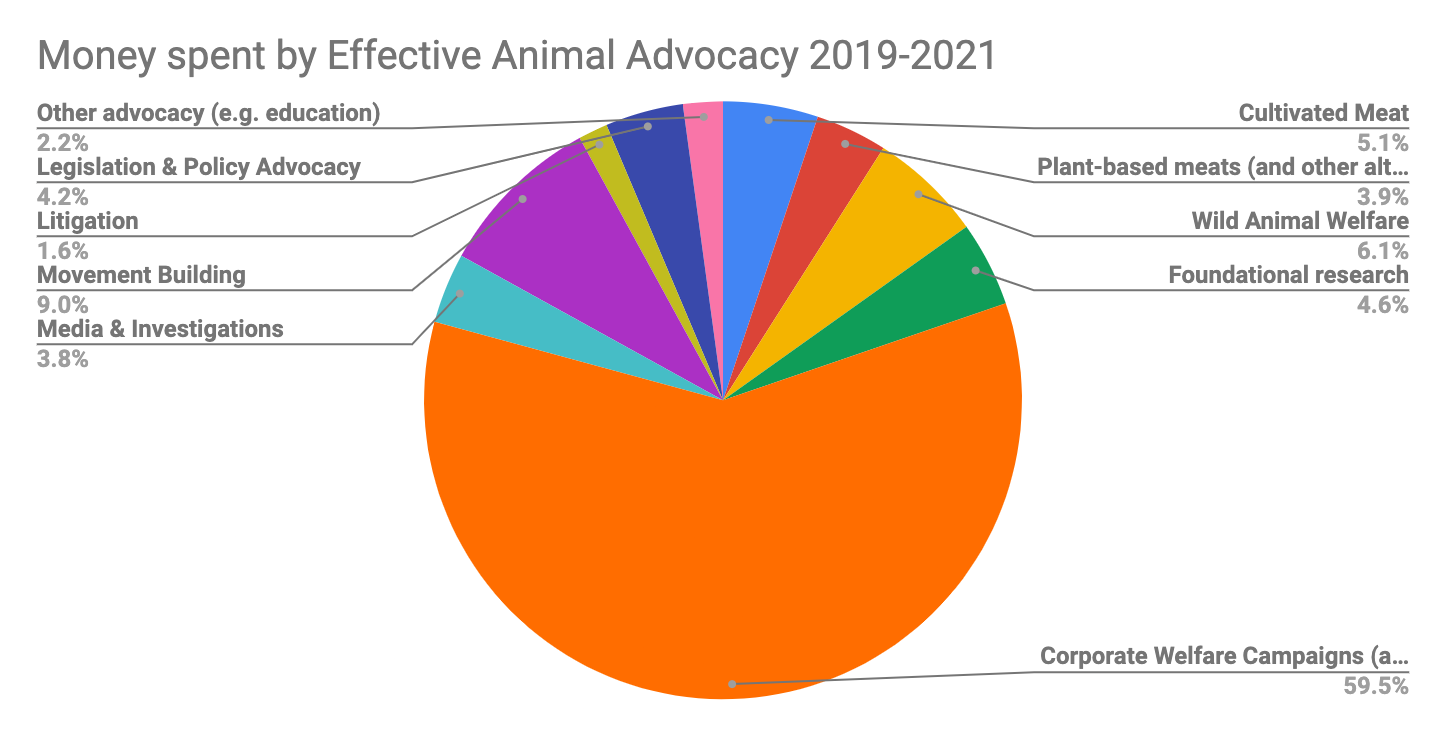
Total EAA funding allocation broken down per year, from 2019-2021
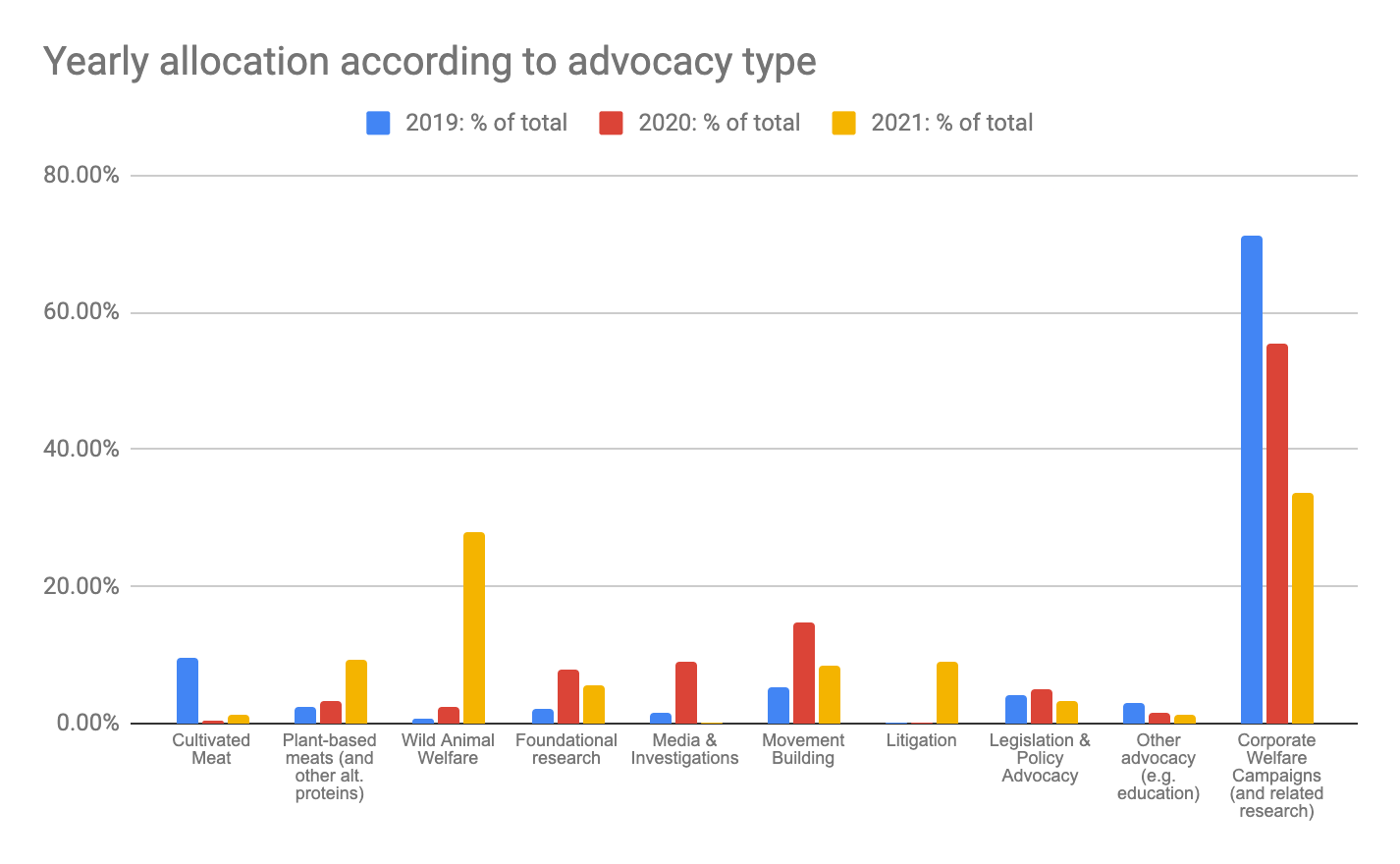
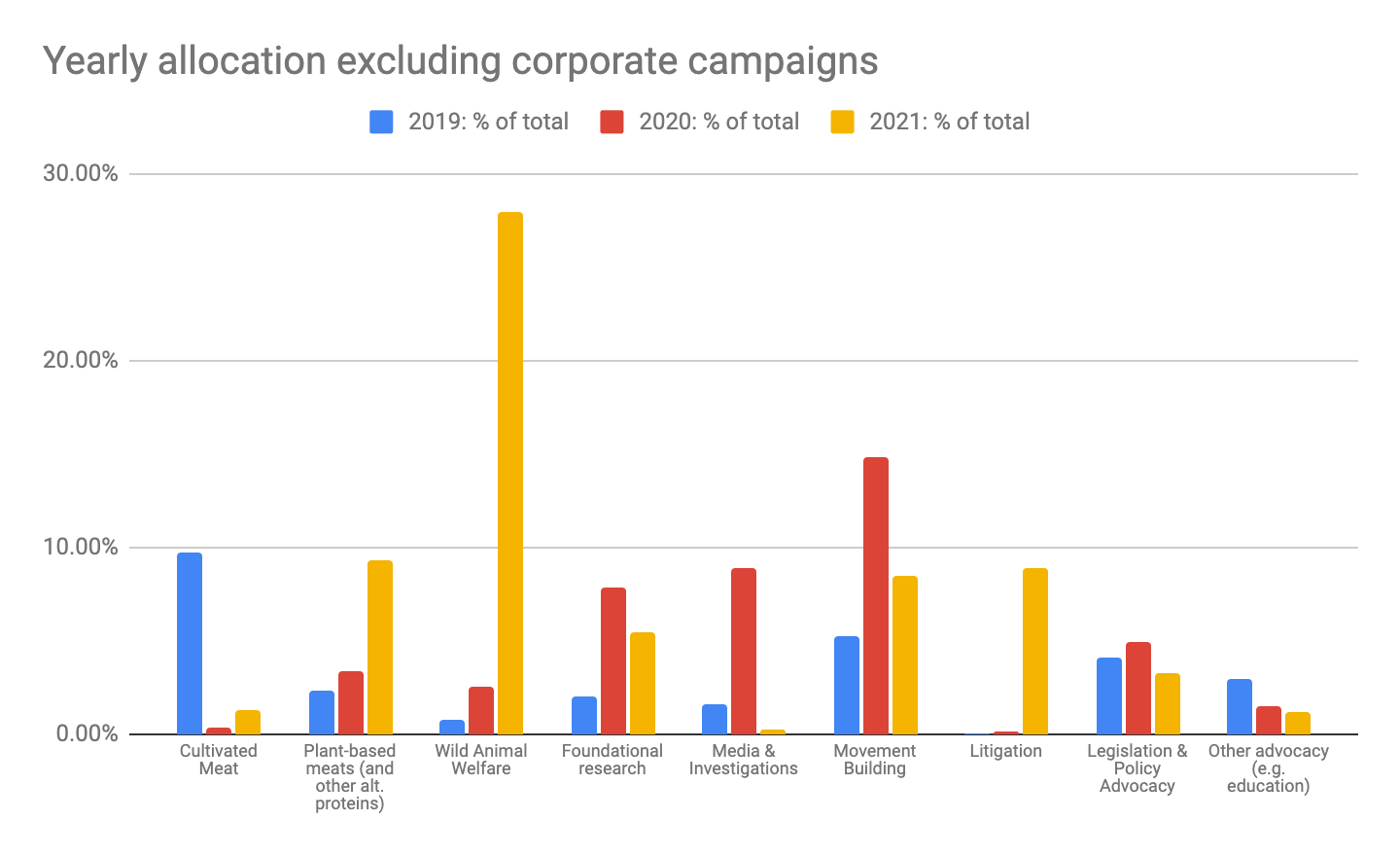
Interesting stuff to note:
- Funding is dominated by corporate welfare campaigns, focusing predominantly on cage-free and broiler campaigns, with a greater number of fish welfare campaigns coming into the mix in recent times. Although, these corporate campaigns seem to be declining in % of total resources allocated, quite rapidly potentially for Open Phil who dominates the EAA funding space. I’m planning on writing more about this shortly but my first (not fully developed) impression is surprise at how much we're funding these campaigns & related research relative to other advocacy methods. See some information on potential reasons why in this post.
- Wild Animal Welfare is really taking off. It is now the second biggest area almost now after corporate campaigns. It went from 0.9% of total funding in 2019 to 28% of total funding in 2021 (so far). As noted by Charles in the comments and myself higher up, take this with a pinch of salt as grant-making can be "lumpy" where there are large multi-year grants given which can skew results over short timescales such as this.
- There’s less funding towards cultivated meat and alternative proteins than I expected, but it does seem to be increasing. One reason for a relatively small amount of donations might be that it’s already quite well funded by the for-profit sector. Another reason could be the relatively small number of good funding opportunities for nonprofits. It'll be interesting to see how recent pessimistic analyses for cultivated meat will affect this funding going forward.
- There’s a relatively small amount of funding towards policy advocacy and legislative change, compared to what I expected, approximately 4.5% average across all three years.
- There is a growing amount of movement building in neglected countries (Asia, South America, Eastern Europe).
- Greater spending on media and investigations than I anticipated. Although from a personal standpoint, some examples such Open Philanthropy’s grant to the Guardian for greater farmed animal welfare journalism really seem to be paying off.
- Litigation seems to have exploded in 2021, although it can most easily be explained by a large grant from Open Philanthropy to Wakker Dier to focus on European litigation for farmed animals.
- Open Philanthropy distributed $39 million for Animal Welfare in 2019, $25 million in 2020 and only $9 million so far in 2021. I'm surprised that this number is seemingly going down, as I thought Open Philanthropy would be ramping up their giving over time due to better domain expertise and greater capacity with more hires. I'm not sure if this is due to lack of good opportunities within the Animal Welfare space, Open Philanthropy prioritising other causes such as longtermism or Global Wellbeing over Animal Welfare or other unknown reasons.
Limitations of this analysis:
- As I allocated these subjectively, everything could be different by up to 2-3% I would imagine. Feel free to leave comments on grants where you think I’ve allocated it incorrectly and I’m happy to change them if appropriate.
- I didn’t include money influenced by ACE (rather than their actual funds), which according to them was another $8 million in 2020 but much harder to track where it went. If anyone wants to take this on, let me know and I can give you access to this spreadsheet.
- Similarly, for time-efficiency reasons, I didn’t include ACE's movement grants, as they're generally a small quantity relative to total funding (and it’s predominantly movement building). Again, more than happy to give access if anyone wants to include these grants.
- The names I chose for these advocacy categories aren’t perfect and they probably could be refined so I’m open to suggestions.
- Some movement building overseas (like Sociedade Vegetariana Brasileira) do lots of different forms of advocacy but the overall purpose of the grants (see write-up by ACE) seems to be general movement building so I went with that.
- Movement building could potentially be split up into building the movement in neglected countries vs general support for organisations like AAC or Encompass but unsure if this will be more useful.
- My classifications for the ACE RCF seem the most likely to be incorrect as they give grants then do a review after 6 months to see what they did, rather than grant for specific purposes beforehand. I generally allocated these based on the reviews I skimmed over and the organisation itself as I know some like Sinergia Animal are predominantly focused on corporate campaigns so it was easiest just to allocate by their main workstream.
- For GFI, I put cultivated meat but of course they’re also focusing on alternative proteins generally so that’s a caveat. I could collapse these two categories into each other for ease of analysis but I was curious to see how much funding was going towards cultivated meat vs plant-based meats, due to the recent pessimistic analyses for cultivated meat. Moreover, GFI engages in this work through research, policy, advocacy, etc. so the separate categories I made for cultivated meat, wild animal welfare and plant-based proteins seem a bit fuzzy.
- This relatively short timescale for data (3 years) means the yearly analysis is less robust to draw conclusions from. I could add 2018 when I have a bit more time but I thought this was useful enough to post for the time being. Or if anyone else wants to do this, happy to give someone access for them to carry on.
- This is only Effective Altruist funding, as I used the 3 biggest animal donors in the EA space. It is not representative of total farmed animal movement, although EAA funding now represents approximately 25% of total farmed animal funding according to this blog by ACE.
Raw totals in $:
Advocacy Type | 2019 | 2020 | 2021 (9 months) |
|---|---|---|---|
| Cultivated Meat | $4,017,036 | $97,812 | $189,844 |
| Plant-based meats (and other alt. proteins) | $963,579 | $935,000 | $1,350,000 |
| Wild Animal Welfare | $335,000 | $701,364 | $4,049,844 |
| Foundational research | $855,518 | $2,207,005 | $789,328 |
| Media & Investigations | $655,000 | $2,488,939 | $38,832 |
| Movement Building | $2,153,563 | $4,158,748 | $1,234,410 |
| Litigation | $8,518 | $35,000 | $1,286,000 |
| Legislation & Policy Advocacy | $1,679,720 | $1,389,645 | $467,000 |
| Other advocacy (e.g. education) | $1,204,817 | $424,600 | $173,664 |
| Corporate Welfare Campaigns (and related research) | $29,377,981 | $15,563,234 | $4,888,829 |
| Total | $41,250,732 | $28,001,347 | $14,467,751 |
Breakdown by organisation:
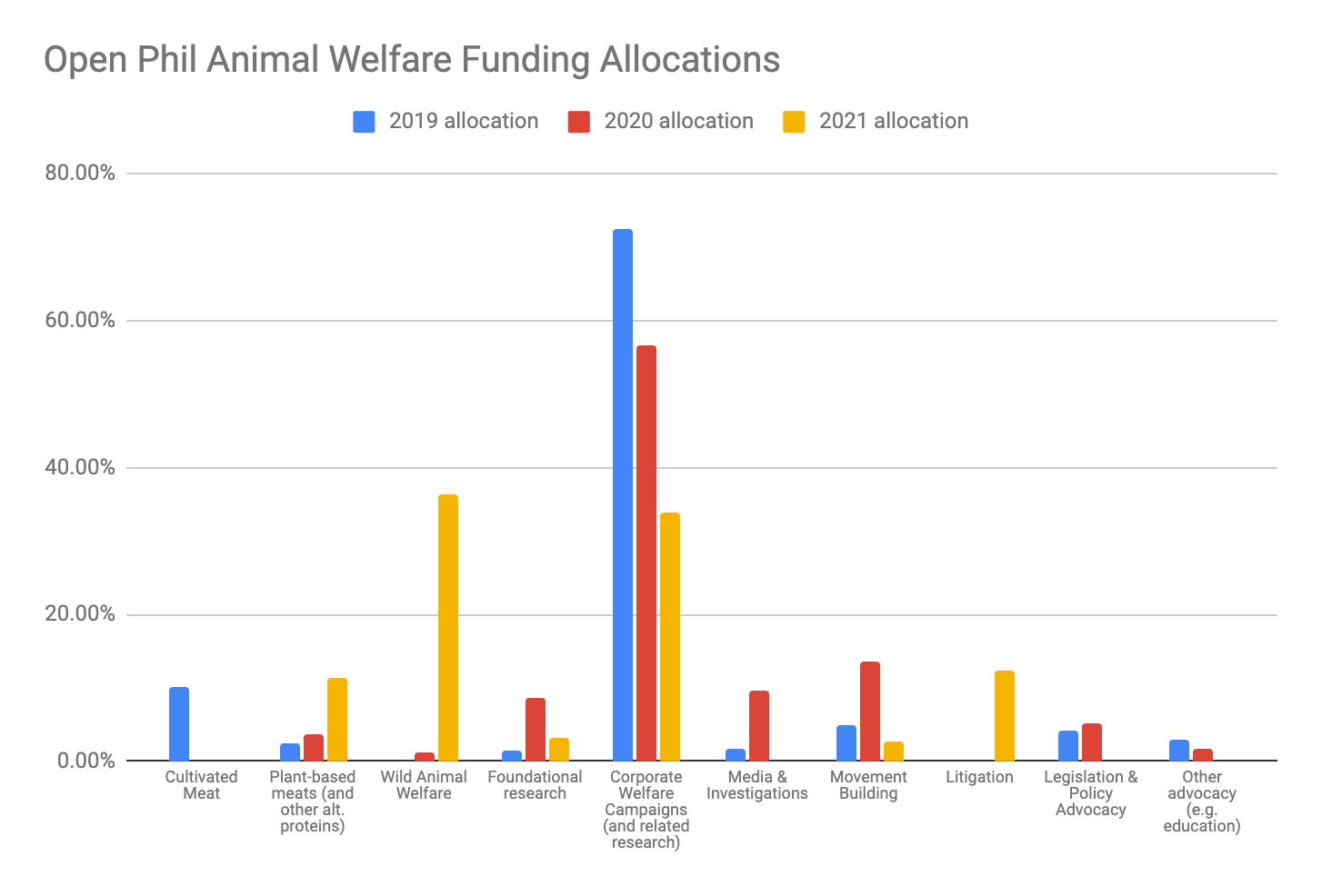
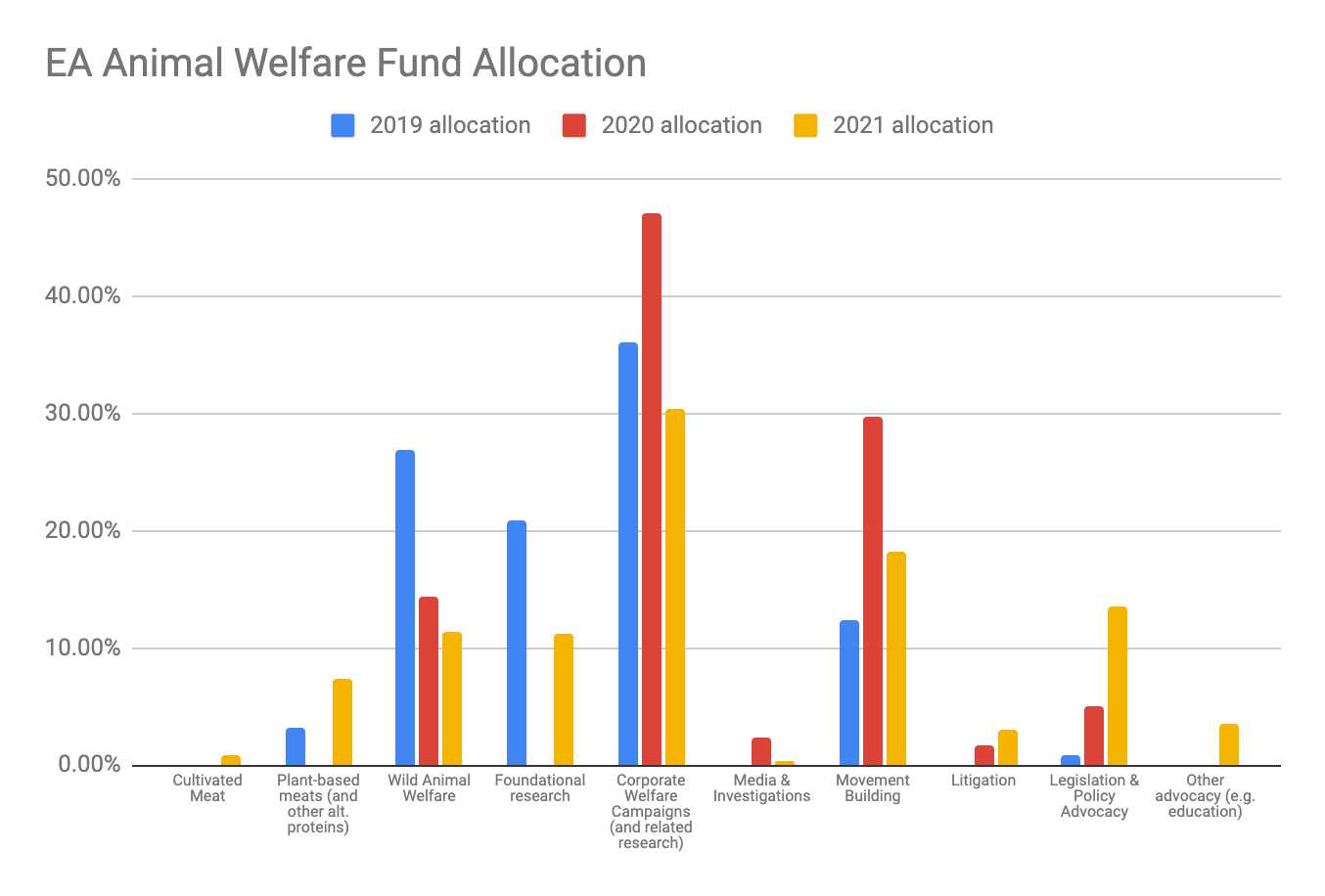
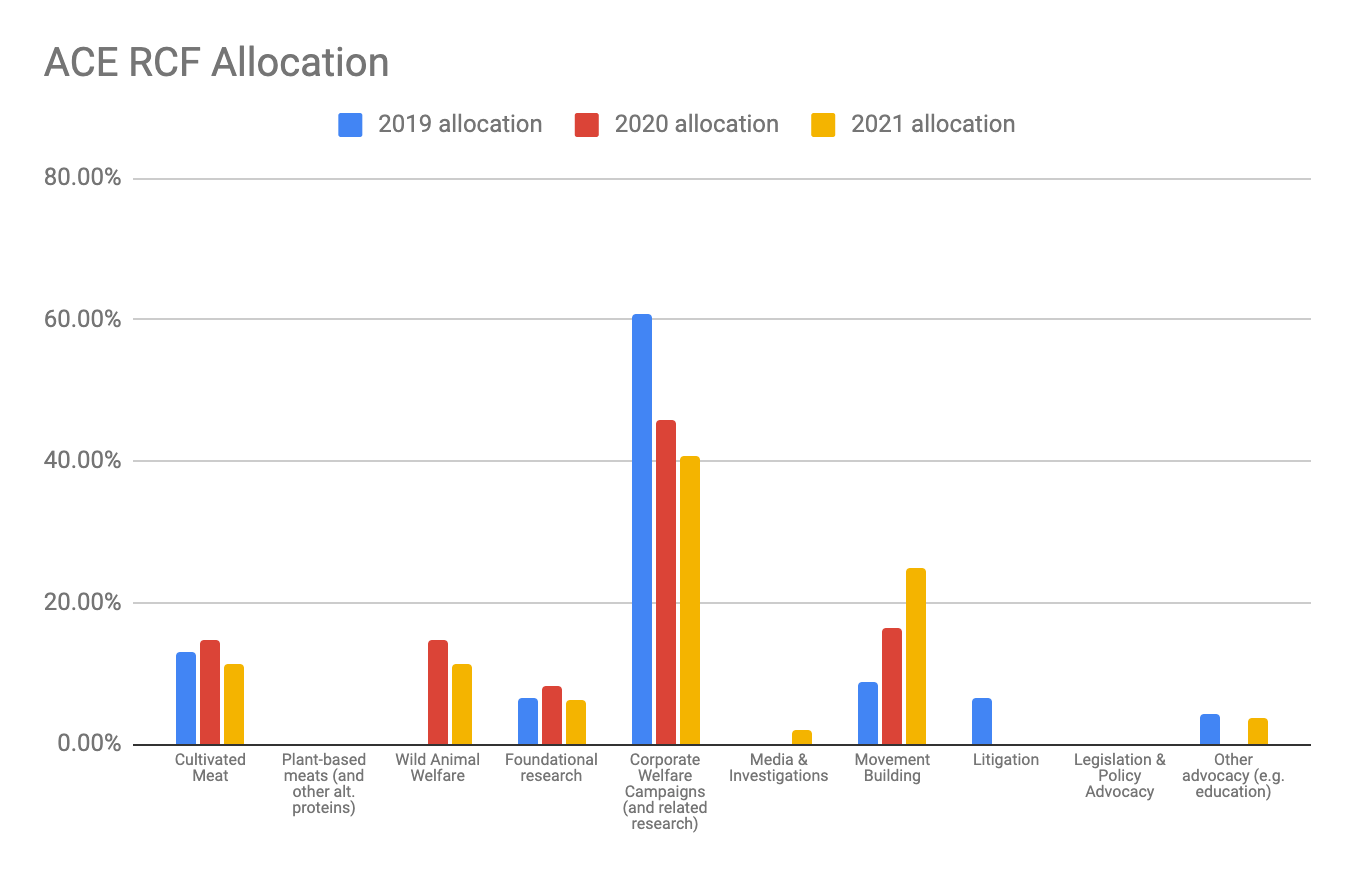
Thanks to Jamie Harris for initial feedback on this analysis.

What is the total amount of funding per year? I don't think I saw it in the post.
Ah yes it was in my spreadsheet but not super clear! I've just added a table to this post and you can see the yearly totals in the bottom row.
Thanks!
I’m unsure about the value of this statement and the implied perspective and understanding.
In general, in farm animal welfare, there’s reason to see access to funding as more of a “bar” to meet instead of a pool of funds to compete over. Indeed, I think there’s eagerness to find new interventions that might be cost effective, or to fund certain foundational causes that seem extremely important.
So if there is not a fixed pool of funds, the meaning of “over invested” is unclear.
Also, there’s just a lot packed into that statement. It’s unusual for anyone in EA to make a statement about overfunding any class of interventions, anywhere. I think it’s equally valuable and demanding of skill, to make useful broad meta statements about existing, operational classes of interventions. It’s plausible this requires at least as much insight, judgement, and management skill as running a successful intervention itself.
I think there’s some value to giving higher resolution when reading some of the statements by the OP.
For example, the most recent grant of wild animal funding is for two years of funding. This has a different meaning than "28% of total funding".
I think this lumpiness applies to other grants.
For this and other reasons, granting can be somewhat noisy (despite, or because it's optimal). So it can be hard to get signal by analyzing past grants.
People might be looking at this data to understand future funding and what interventions/areas seems particularly valuable. To try to answer this directly, I think that a reasonable guess is that if you want to know of areas where there is funding interest (including by Open Phil), the statements by the EA Animal Welfare is a really good guess:
Hey Charles, thanks for the response!
A few quick points:
EDIT: On reflection, I thought my initial statement was stronger than I wanted to so I've reworded it to:
So thank you for raising this Charles.
“There’s a relatively small amount of funding towards policy advocacy and legislative change, compared to what I expected, approximately 4.5% average across all three years.“
Could you elaborate on why you were expecting more?
I love this analysis, thanks for taking the time to put it together. I would not have expected it to be so lopsided toward corporate campaigns either.
This is really great. Thank you! Are you able elaborate on international spending on movement building?
Good question - I considered doing a separate advocacy category for this but decided against it for some reason. I re-did some of the analysis with this new category (see new spreadsheet here) and the results look as below.
As you can see on the far right hand side, there's a relatively steadily increasing number of funds going towards international movement building, specifically in neglected countries. That matches well with the request for proposals by the EA Animal Welfare Fund.
Thank you for this!